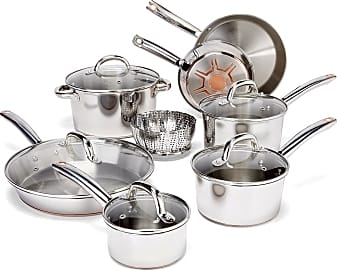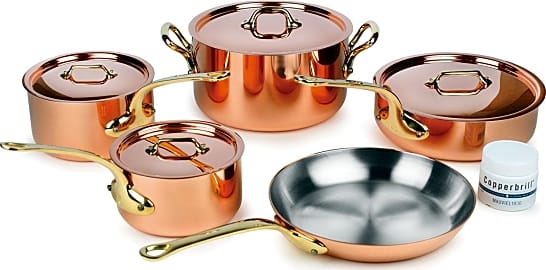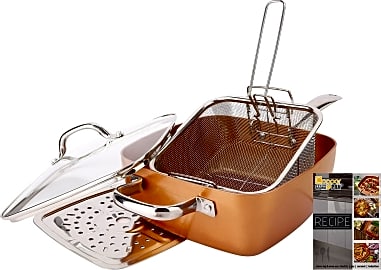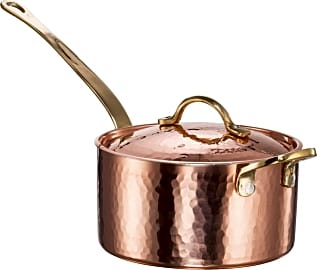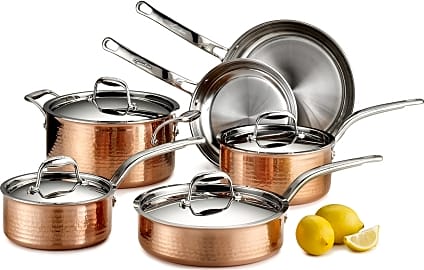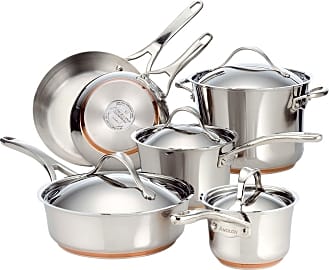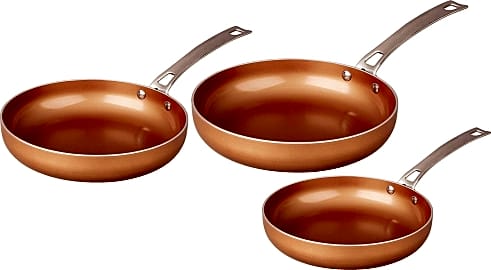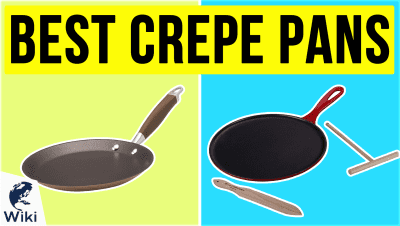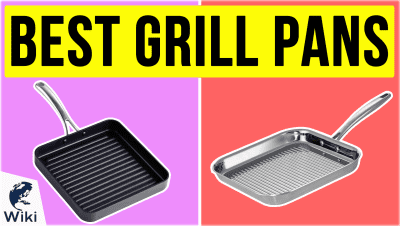The 9 Best Copper Pans

This wiki has been updated 36 times since it was first published in February of 2016. Whether you're a professional chef, a knowledgeable home cook, or just tired of burning every meal you try to prepare, splurging on copper pans can make life in the kitchen much easier and more delicious. The faster cooking time alone can make them worth the investment. Our selections include full sets along with single pieces if you're not ready to replace all your pots and pans yet. When users buy our independently chosen editorial selections, we may earn commissions to help fund the Wiki.
Editor's Notes
May 27, 2021:
The only alteration to this edition of the Wiki was the removal of a Cuisinart set that's no longer available. Otherwise, our recommendations run the gamut from affordable, copper-containing options like the T-fal Ultimate to ultra-premium sets like the Matfer Bourgeat 8 Piece. Matfer Bourgeat is known as one of the finest cookware manufacturers in the world, and their 8-piece offering is no exception. The Mauviel M'heritage M250B is just about as top-quality, although the lids don't quite measure up to the pans themselves. If you just want something that looks nice and cooks well, consider the Concord RCN300, which isn't crafted with any solid copper layers but has a high-quality nonstick finish.
If you want to build your own premium set piece by piece, consider the Ruffoni Historia collection mentioned in the Special Honors section. They offer a wide range of high-end cooking implements that are sure to impress both cooks and guests.
January 30, 2020:
When evaluating the best copper pans we took into account that not every cook who wants to take advantage of copper's unique benefits has the budget for the beautiful all-copper exteriors that chefs want to display in their upscale kitchens. So we included truly budget conscious options like the T-fal Ultimate set. The temperature control is not nearly as sensitive as options with a thicker copper layer, but users will experience more even heating, for not much more than the brand's basic aluminum offerings.
While the well-heeled might choose the gorgeous Matfer Bourgeat 8 Piece or Mauviel M'heritage M250B set as the perfect accent to their prestige kitchens, cooks who are serious about leveraging the unsurpassed temperature control and even heating copper offers might want to save up for this investment as well. They offer a thicker layer of copper than less expensive choices, married with the thinnest possible layer of stainless steel inside.
The higher ratio of copper to other metals does make the best cookware. The traditional way of making copper pots safe for cooking was to paint a layer of tin inside, as in the Demmex Saucepan, to prevent the copper from reacting with certain foods and leaching into the meal, but modern cooks generally don't want the extra maintenance of taking their pots and pans to be re-tinned periodically.
The most practical in terms of maintenance while maintaining the best quality is the All-Clad Saute. All pieces in this copper core line provide the copper layer all the way up the sides to the rim of the pot, not just on the base, but you won't need to polish it after every use. The saute pan is a great starting piece for those who want to build their collections slowly.
Special Honors
Falk Classic The Falk Classic frying pan's copper layer has a warm brushed satin finish that's a little easier to maintain than polished choices, or you can let it develop an antique patina. The low flared sides and flat bottom of this piece promotes optimal searing and browning. If you want a lid, it's sold separately and rather expensive. copperpans.com
Ruffoni Historia Ruffoni's classic line of cookware is hand-hammered from a single piece of copper with the nonreactive tin lining applied by hand over fire. The brand's distinctive hand-cast bronze lid knobs add a decorative yet functional touch. ruffoni.net
Reasons To Cook With Copper
Copper pans are prized by chefs because they are ideal heat conductors.
Copper pans are prized by chefs because they are ideal heat conductors. In fact, they conduct heat 20 times better than stainless steel. They heat up more quickly and maintain their temperature better, giving cooks more precise control when crafting delicate sauces, cooking down jams for canning, or making candy. But copper pans are not only useful for specialty recipes; they can improve your everyday cooking, as well.
This gorgeous cookware need not be kept in storage for holiday meals, or those rare days you have time to dabble in fine French cuisine. Copper pots are among the most durable cookware options available, and they're ideal for mundane tasks such as sautéing and stir-frying. Because of the instant temperature regulation, you won't be tempted to blast your creations on high and risk over-cooking or scorching the pan. The instant, uniform heat transfer across the bottom as well as the sides of the pan means you don't have to monitor and stir your dishes constantly to achieve excellent results. When you regularly use copper cookware, you'll notice that your meals are finished faster and you'll be using less energy. If you've got a spouse or a teenager who's often running late for dinner, your copper pot will retain heat longer than regular ones, so you don't have to leave the stove on for your loved ones to come home to a warm meal.
It's a little known fact that copper is toxic to harmful microorganisms such as bacteria and viruses, yet this same antibacterial effect is perfectly safe for humans. For this reason many water pipes and door handles in hospitals are also made of copper.
A set of copper cookware hanging from your pot rack adds a warm accent to any style of kitchen. In many homes, kitchens are no longer a hidden corner of the house, but the decorative center of an open concept floor plan. Even if you don't cook very often, you might want to invest in a few copper pieces to complement your decor. And someday when you get around to learning to cook, these durable work horses of the kitchen will have you preparing tasty meals in style.
Caring For Your Copper
It's a common myth that copper pans are difficult to care for, but if you learn how to use them properly, maintaining that beautiful shine is a breeze. Because copper is so efficient with heat, you almost never need to cook on high, reducing the chance you'll discolor the finish in the first place. But there's no need to despair if your teen's first foray into the kitchen includes a burnt-to-a-crisp grilled cheese and the high-pitched beeping of your smoke alarm.
They're relatively inexpensive, don't require any elbow grease to apply, and rinse off quickly during regular dish washing.
You can easily maintain your copper's attractive finish and remove most discoloration by cleaning the exterior with one of the commercial copper cleaning creams on the market. They're relatively inexpensive, don't require any elbow grease to apply, and rinse off quickly during regular dish washing. If you prefer a more natural approach, you can simply take half a lemon, sprinkle it with a little table salt and rub. Another option is to mix equal parts baking soda and lemon juice into a paste and rub with a soft cloth. The mild abrasive qualities of the salt or baking soda should be enough to remove most tarnish. Over time, all copper will develop a darker vintage-looking patina, but regular care will keep away ugly scorch-marks and water spots.
Because copper reacts with acidic foods and can leach into your meals, nearly all copper cookware is lined. The traditional lining is a thin layer of tin. The advantages of a tin lining are that it retains all the copper's heat conductivity and has a non-stick quality without chemicals or the need for seasoning; but you should choose non-metal utensils safe for nonstick cookware and never scrub the interior with anything highly abrasive. In addition, the tin lining can wear down over time (about 15 years or so), and eventually require re-tinning. If you don't want to deal with caring for the tin interior, you can find copper pans that are lined with stainless steel. The stainless lining reduces the thermal properties of the copper, but you'll still get the beautiful look without worrying about the interior.
A Brief History Of Copper Pans
While archaeologists have found copper artifacts in the Middle East dating back over 9,000 years, these were primarily small tools or decorative objects. As copper is one of the most plentiful metals found in the Earth's crust, it was used and prized by ancient people around the world. The usage of copper as a cooking vessel became possible with the invention of the smelting process of extracting ore into a workable metal, around 5000 B.C.E.
It was during the Neolithic period that copper began to replace stoneware as a common cooking utensil.
It was during the Neolithic period that copper began to replace stoneware as a common cooking utensil. It's durability and relative pliability allowed it to be shaped into large pots, and it's antibacterial properties were well-known through out the ancient world. Early Egyptians were known to use copper vessels for safely storing water and oil.
Advances in metallurgy and the growing knowledge that too much copper in the diet was poisonous led to the practice of lining metal pots with a thin layer of tin. This lead to a safer cooking surface with all the same positive properties of a pure copper pot, resulting in a reliable piece of cookware that could be left on the fire all day.
While the Industrial Age vastly changed the way copper cookware is made, you can still find artisans today who hand-hammer molded pots and pans, and hand wipe the tin interior.



